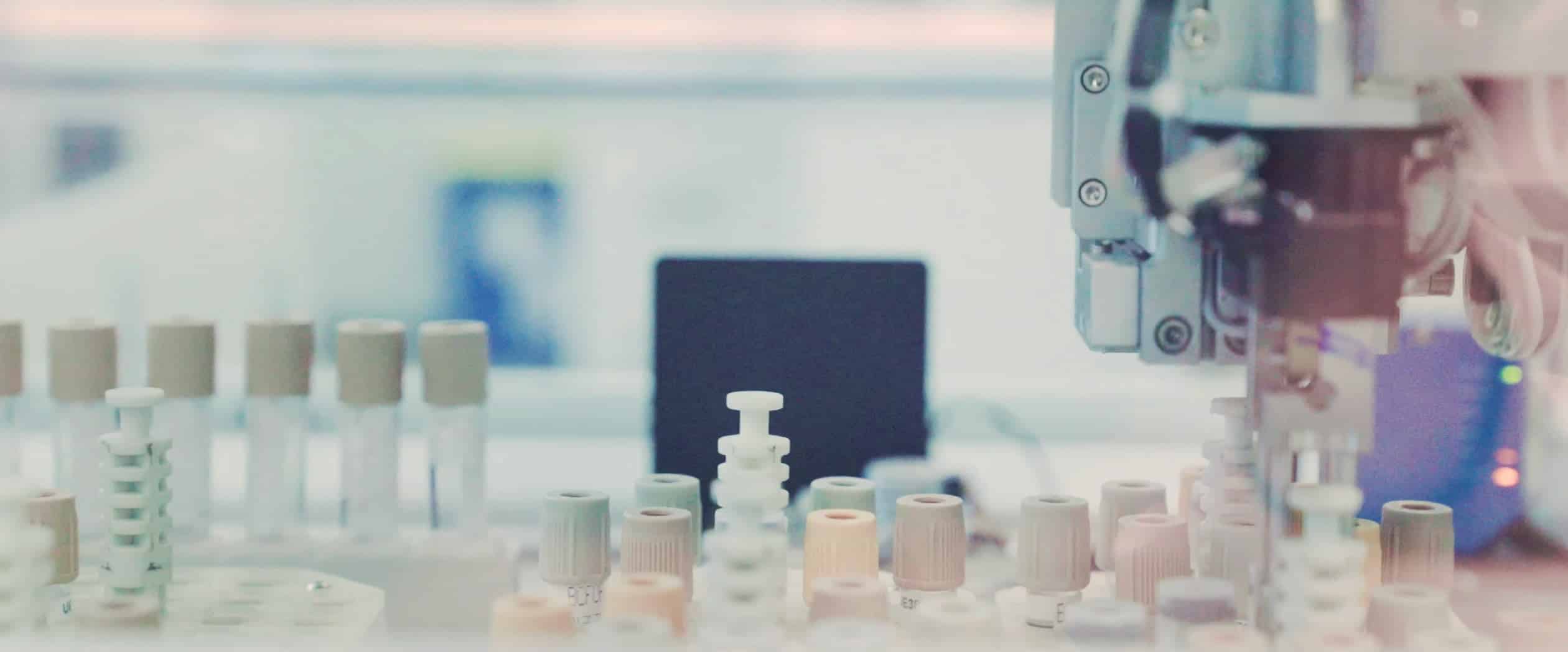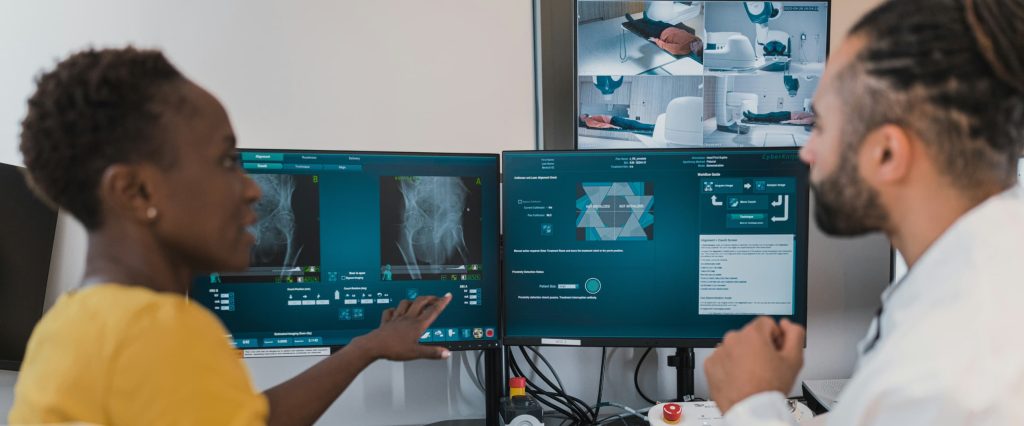How Automation in Healthcare Enhances Patient Outcomes and Reduces Costs
How automation, including methods such as AI, ML, and RPA, is transforming healthcare is by addressing key challenges and enhancing patient care, administrative efficiency, and data management. This article explores the transformative power of medical automation and demonstrates its capacity to optimize operations and improve effectiveness. Continue reading to discover how these technologies are being implemented to refine workflows, reduce manual tasks, and empower healthcare professionals with enhanced insights for better decision-making.
The blog discusses:
- the definition of automation in healthcare
- why it’s important
- what can be automated in healthcare
- technologies for automation
- implementation challenges

Table of Contents
Automation surely is a critical tool for driving efficiency, cost-effectiveness, and accessibility in the medical industry. However, it’s worth bearing in mind that human oversight remains essential for maintaining the quality of patient care. In this article, we will look into the practical examples from AWS experts to illustrate how automation can be effectively applied in medical settings.
Table of Contents
What is Healthcare Automation
Healthcare automation is defined as the use of approaches like artificial intelligence (AI), machine learning (ML), robotic process automation (RPA), and cloud computing with the goal of accelerating administrative, clinical, and operational workflows in healthcare. This method fulfills multiple purposes, as it helps streamline processes, reduce manual tasks, and minimize errors, which enhances efficiency, accelerates innovation, and improves both patient care and business outcomes in the long run. Healthcare automation is appreciated for enabling healthcare providers to concentrate on providing high-quality patient care instead of focusing on mundane tasks.
Benefits of Automation in the Healthcare Industry
Automating various tasks and processes helps reduce expenses, improve resource allocation, and expand access to care for more patients. For this reason, healthcare providers in the automation healthcare industry are implementing solutions to address challenges related to cost, access, and operational effectiveness.
Integrating this approach brings many benefits, such as:
- Drug Development and Clinical Trials Acceleration
With the use of artificial intelligence and machine learning, automation in healthcare speeds up processes tied to drug discovery, clinical trials, and new therapy development. Instead of requiring time and expenses, tasks such as target identification, protein design, and clinical trial management become streamlined by automation, leading to faster drug approvals and quicker patient access to life-saving treatments. - Reduction of Clinical Documentation Burden & Data Management Improvement
Clinical documentation consumes a substantial amount of time, which can lead to burnout. AI and natural language processing (NLP) introduce the solution to this problem by automating various tasks (e.g., note-taking, discharge summaries, and report generation) and so allow medical experts to focus on patient care. Another benefit of automation in healthcare is that it enhances data harmonization, analysis, and decision-making, and through these advances, it enables better clinical insights and operational efficiency. - Modernized Operations and Optimized Supply Chains
When implemented into a system, automation enables optimization of IT infrastructure, operational workflows, and supply chain management – a feature that helps minimize manual interventions in a number of processes (e.g., system management, inventory tracking, software deployments). This leads to reduced expenses, more reliable systems, enhanced medication delivery, minimum waste, and efficient patient treatment. - Compliance, Security, and Risk Management Support
Automation, when applied to aspects like regulatory compliance, data monitoring, and cybersecurity measures, helps healthcare organizations adhere to legal requirements and protect sensitive patient data. In a long-term perspective, this will guarantee privacy protection, minimize security risks, and ensure high-level data integrity.
Types of Healthcare Automation
Healthcare automation can be categorized in several ways, as it streamlines a variety of different processes. In this section, we will focus on key automation types in the healthcare industry.
Research and Drug Development
Automation in healthcare minimizes time-to-market for new therapies by accelerating drug discovery, target identification, and molecular design. These technologies are applied in multiple areas, namely:
- Target Identification
Instruments like artificial intelligence and autonomous agents examine both internal and external sources of data to detect and validate biological targets, which significantly reduces research time. - Lead Identification and Optimization
Generative AI models help speed up the development of new drugs by predicting their properties and allowing researchers to create protein designs. - High-Performance Computing (HPC) Automation
With the help of automated simulation and modeling tools, companies such as Merck can optimize drug target discovery and accelerate complex research activities.
Clinical Trial Automation in Healthcare
When it comes to clinical trials, automation speeds up every stage of the drug approval process, from planning to execution and data analysis. In this case, automation is utilized in two key ways, and those are:
- Data Cleaning and Analysis
Some programs, such as Merck’s Zero Gravity, automate data processing during clinical trials. - Modernized Data Infrastructure
Equipped with automation, platforms help improve trial processes via structuring and integrating clinical datasets, thus reducing the amount of time spent on research.
Clinical Documentation
Usually, task documentation is a time-consuming process. This can be addressed with automation in two main ways, which are:
- AI-Powered Documentation
Generative AI and Large Language Models (LLMs) automatically produce various kinds of documents: clinical notes, discharge summaries, and patient reports. - Automated Summarization
Tools like Pieces Technology summarize data and simplify documentation, which improves clinician efficiency and reduces burnout.
Healthcare Data Management and Analytics
Automation in healthcare allows for a smooth process of acquiring, transforming, and analyzing data to improve decision-making. This type of automation involves four main aspects, specifically:
- Metadata Harmonization
Automation in systems is applied to data integration, which simplifies access and analysis of medical records. - Data Pipelines
Patient information can be automatically ingested, processed, and published with services like Gilead’s data platform. - Medical Imaging Management
Certain tools, such as AWS Health Imaging, can automate processes like storage and analysis of medical images, which further simplifies radiology and diagnostics. - Text-to-SQL Automation
AI tools can understand plain language and automatically create the specific code (SQL queries) needed to pull data from organized databases, and make data extraction easier.
IT Infrastructure Automation
In managing IT resources and cloud environments, automation considerably reduces workload. It is usually implemented in three key ways, particularly:
- Cloud Infrastructure Management
Services leveraging automation simplify the processes of provisioning, compliance, and operational monitoring. - Hyper Automation for Migration
Automation removes time-consuming manual processes in data center migration and IT operations. - Automated Patching and Compliance
In terms of standard requirements and evolution, automation delivers system updates and ensures regulatory compliance without manual intervention.
Supply Chain
By automating medical supply chain management, organizations can achieve efficient demand forecasting and inventory planning. There are two main ways in which automation is integrated, namely:
- Real-Time Logistics Tracking
To prevent vaccine spoilage, automated systems track vaccine shipments and storage conditions, such as temperature. - AI-Powered Forecasting
Generative AI improves how healthcare organizations view their supply needs, which results in automated planning for required supplies.
Security and Compliance Automation in Healthcare
Automated data protection and regulatory compliance in the healthcare industry are represented by three main points, which are as follows:
- Automated Security Monitoring
Security threats are promptly detected and addressed by AI-powered tools. - Regulatory Compliance Automation
By maintaining continuous compliance monitoring, organizations ensure that healthcare workloads meet industry regulations and breaches are detected in time. - Centralized Cloud Security
Automated cloud vulnerability management, a key security measure, can be achieved with platforms like Prisma.
How Healthcare Automation Impacts Patient Care
Implementing automation in healthcare systems not only streamlines and optimizes care delivery but also improves the overall process of reception, access, and effect of medical services. In this section, we will focus on specific aspects of how automation improves patient care.
Accelerated Therapy Development
Implementing AI-powered automation in research and development has proven to be an effective way to accelerate the process of launching new therapies. With the help of various platforms and services (e.g., Amazon Bedrock), procedures related to drug discovery, such as target identification and biomarker detection, are being continuously enhanced. To illustrate, automated agents save researchers tens of thousands of working hours every year, which means a faster launch of critical treatments.
Improved Diagnostics and Support
Generative AI, with its ability to drive advanced clinical decision support systems and diagnostic tools, helps organizations synthesize both structured and unstructured data in large volumes. The implementation of Generative AI leads to prompt interventions, better-aligned treatment plans, as well as faster and more accurate diagnoses. Ultimately, these features contribute to improving patient outcomes.
Reduced Clinical Documentation Burden
Automation in healthcare helps alleviate administrative workload by replacing manual intervention in tasks like note generation and discharge summaries. Some solutions integrate large language models and allow medical professionals to focus on patient interactions instead of documentation tasks. Such use of automation has resulted in smoother care transitions and reduced delays in post-discharge coordination.
Faster Access to Medications
Automation-powered digital platforms simplify the process of obtaining prescribed medications by minimizing obstacles across all the stages of the procedure, from appointment scheduling to insurance processing and delivery logistics. In areas with limited pharmacy access, where the medication must be obtained no later than on the same day as the prescription, this feature could be critically important.
More Efficient Clinical Trials
Automation in clinical research, particularly AI, is used to improve the quality and rate at which the data is processed in multiple ways: it enhances trial design, automates blinding and data masking, and accelerates regulatory workflows. With these advances, medical solutions are developed faster, and patients have earlier access to potentially life-saving treatments.
Reliable Medication Supply Chains
Supply chains are getting increasingly resilient and responsible with the use of automation. This approach ensures that across all stages of medication distribution, from real-time shipment tracking to intelligent forecasting and temperature-controlled logistics, medical systems guarantee safe, prompt, and robust vaccine delivery.
Better Use of Clinical and Operational Data
While medical datasets are often complex, the use of regular language interfaces and AI-powered query tools helps patients and medical professionals extract important insights more efficiently. Automated text-to-SQL technologies, in this case, serve multiple purposes: they allow for faster and more accurate data analysis, drive evidence-based care decisions and personalized treatment approaches, and support more effective resource planning.
Healthcare Automation: Real Use Cases
In this section, we will provide use cases derived from real-world implementations shared by AWS subject matter experts during AWS re:Invent 2024. Each example represents verified healthcare automation strategies in production environments and includes references to official AWS case studies.
Summarization of Patient Records using AI
Cleveland Clinic uses Amazon Bedrock’s services to generate concise summaries of a patient’s entire hospital record (100-200 words) every 2 to 15 minutes. With this method, clinicians are not burdened by hours of thousand-page documentation reviews, and instead gain a quick and comprehensive understanding of a patient’s hospital course.
Similarly, clinicians use generative AI to design draft discharge summaries that are essential for the transition of care to outpatient physicians, and by doing that, avoid spending from nearly 60 to 90 minutes per clinical shift doing it manually, which notably improves efficiency. This accelerated access to critical patient information for informed clinical decisions is evident in the Cleveland Clinic’s rapid response team’s use of real-time summaries.
Genentech’s Automated Drug Target Identification
The next example is how Genentech implements a research agent using Amazon Bedrock services to achieve automation of drug target identification. Leveraging both internal and external tools, this agent rapidly detects targets for new medicines and biomarkers for trials. With this automation, the time required for this step in drug discovery has been reduced from weeks to minutes.
According to Genentech’s calculations, this will help their scientists save 43,000 hours per year (approximately five years of one person’s full-time work) across all of their operations and focus more on core research rather than time-consuming manual data research.
Data Extraction from Databases using Text-to-SQL with AI
To assist the teams that analyze real-world medical data, Merck has developed a generative AI-powered system that automatically converts regular language questions into SQL queries that are later used to retrieve data from databases. Through this approach, users who are not expert programmers (citizen data scientists) can send queries to complex medical databases using questions in their natural language.
The designed system automatically generates SQL queries using natural language instructions, database schema, sample data, and optional examples. For maximum efficiency, this system utilizes tools to handle ambiguities and provides a summary of the generated query for the user to verify before proceeding. The accuracy rate of the system is nearly 80% on the first attempt, and even higher with additional clarifications. Leveraging this approach opens up access to viewing and analyzing critical medical data more efficiently without relying on SQL experts, as well as gaining relevant insights much faster.
Challenges of Implementing Healthcare Automation
Implementing automation in the healthcare industry, despite its multiple benefits, also presents several challenges that organizations must carefully navigate. For this reason, partnering with an experienced healthcare development services vendor can effectively address these complexities and ensure a smooth and successful adoption of automated solutions.
The key hurdles of integration of automation in the healthcare industry include:
- Data Access, Integration, and Quality
Medical data often exists in isolated systems and different formats (structured and unstructured), and lacks interoperability. This leads to automation being hindered by incompatible metadata schemas and inconsistent data quality, and can negatively impact patient care and regulatory compliance. So, it is worth establishing data accuracy, completeness, and governance. - Technical Complexity and Skill Gaps
AI and automation technologies demand diverse expertise, from skills in model training to software pipelines and infrastructure scaling – specialized knowledge that many professionals may not possess. The lack of training creates reliance on specialized teams even for simple tasks like querying databases, a challenge that results in operational bottlenecks and slows down the adoption of new approaches. However, these challenges in implementing AI and automation in healthcare can be addressed by partnering with a reliable healthcare development services vendor. - Organizational Readiness and Change Management
In order to successfully implement automation in healthcare, organizations must undergo a cultural shift that involves aligning IT and business objectives, fostering collaboration, and embracing change. Considering how many healthcare organizations hire outsourced IT professionals, it is essential to choose the right partner that possesses the required expertise. It is crucial to understand that the lack of skill improvement and modernization efforts might negatively affect the organization even after deployment. - Workflow Integration and Legacy Systems
Given that many healthcare facilities are built upon legacy infrastructure with deeply embedded workflows, it might be difficult to migrate processes or integrate automation solutions without disrupting operations. Therefore, make sure that automation is compatible with on-premise systems and does not increase latency or compromise continuity. - Financial and Resource Constraints
Combined with necessary operational expenses, maintaining automation might be quite costly. So as to make rational investments and achieve financial gains, implementing strategies for budget forecasting, procurement, and cost optimization is absolutely necessary. - Accuracy, Trust, and Continuous Improvement
Ensuring successful automation in the healthcare industry calls for maintaining system integrity, specifically through continuous testing, validation, and feedback loops. Another indispensable part of the system’s ethical foundation is the system’s trustworthiness, which demands transparency and accountability. Finally, with the continuous evolution of AI and automation comes the need for constant updates in the workflows to keep up with advancements.
Future Trends of Automation in the Healthcare Industry
The future of healthcare is expected to see a significant transformation driven by automation technologies. From streamlining administrative tasks to enhancing diagnostic capabilities and personalizing treatments, automation holds immense potential to improve efficiency, reduce costs, and thus enhance patient outcomes. There are several key trends and anticipated advancements shaping the landscape of automation in healthcare’s future, specifically:
- Enhanced Utilization of Real-World Data (RWD)
As medical data grows in volume and complexity, automated solutions are growing in demand for its analysis. In the future, we are likely to see expanded usage of automation in healthcare, particularly the use of de-identified RWD for purposes such as drug target detection, clinical trials optimization, and patient care improvement. To accommodate the increasing data demands, platforms like AWS Health Lake provide tools that enable secure data storage, transformation, and analysis. - Smart Automation in Clinical Trials
Given how important automation is for performing clinical trials with minimized time and cost of drug development, in the future, AI and machine learning will also be used to optimize trial design, streamline data cleaning and analysis, and accelerate patient access to medical solutions. - Advancements in Medical Imaging with AI
With the migration of data to the cloud and the development of powerful foundation models, will come an even greater demand for the use of automation in medical imaging analysis, which will trigger faster and more accurate diagnoses and potentially new instruments for diagnosis. - Smarter and More Resilient Medical Supply Chains
AI-powered automation is anticipated to be a crucial part of optimizing healthcare supply chains to ensure prompt delivery of critical supplies like vaccines. Its methods will include using generative AI agents to allow users to ask complex questions about supply chain data and receive concise and understandable answers. - Convergence of High-Performance Computing (HPC) and AI/ML
Complex infrastructures associated with HPC are expected to be increasingly more utilized for training and running large AI models in the healthcare industry. The outcome of this integration would be accelerated advancements in various areas (e.g, drug discovery, genomics, and personalized medicine) and the ability to handle computationally intensive tasks on a large scale. - Cloud-First and Hybrid Cloud Strategies
In the future, workloads will be further migrated to cloud environments, necessitated by the demand for scalability, security, and access to advanced services like AI/ML. Healthcare organizations are highly likely to leverage hybrid cloud solutions like AWS Outposts as they enable running applications on-premises while accommodating latency-sensitive workloads and data residency requirements with AWS services. - Focus on Operational Excellence and Continuous Improvement
Automation is the driving force behind operational excellence in healthcare IT. Therefore, in the future, organizations are expected to maintain their focus on automating time-consuming manual tasks, governance, and compliance while using cloud environments to build resilient, scalable, and self-service IT infrastructure. What will also increase is the usage of AI/ML and real-time analytics to support adaptive, self-optimizing capabilities. - Proactive Healthcare and Predictive Analytics
Finally, automation will enable healthcare organizations to efficiently analyze patient data, identify risks, and guide preventive interventions. We are currently in the early phase of this trend, with the use of AWS Snowball as an example.
Frequently Asked Questions About Healthcare Automation
In healthcare environments, RPA is used to automate repetitive administrative and clinical tasks with the view to increasing efficiency, reducing errors, and lowering costs. There are several key applications, such as:
- Administrative Automation
This solution takes over such procedures as insurance verification, processing, medical billing, and appointment scheduling.
- EHR Management
Tasks within EHR Management include data entry, record updates, duplicate record removal, and compliance reporting.
- Clinical Support
To ensure continuous automation in clinical workflows, prescription processing, lab report management, and staff scheduling are automated.
- Patient Engagement
Features like chatbots, automated reminders, and remote monitoring are highly important for improving patient interaction.
HTA stands for Health Technology Assessment – a structured process designed to assess a system's characteristics, like clinical effectiveness, safety, cost-effectiveness, and organizational impact of medical technologies. The latter involve drugs, devices, diagnostics, treatment protocols, and digital health solutions.
The importance of HTA lies in its evidence-based insights that help ensure that strategic investments in new technologies contribute to patient care and operations. Aside from practical insights, HTA also helps healthcare organizations align technology adoption with business expectations, whether those are regulatory, clinical, or financial, and ensure that digital tools and platforms comply with the goals of the organization.
Despite its benefits, automation in healthcare has possible negative effects, and they lie in job displacement, high implementation costs, ethical and legal concerns, and data security risks. Automation might eventually lead to a significant decline in human interaction, which is likely to affect patient trust. Additionally, the diagnoses performed by AI-powered systems might be biased and lead to further disparities in patient care. System errors and malfunctions, in turn, will pose a threat to patient safety. Even though this approach greatly improves healthcare, human intervention and careful oversight are crucial to avoid errors.
While automation in healthcare optimizes data management, it can also endanger patient privacy and security. The work of automated systems centers around large volumes of sensitive health data – a prime target for cyberattacks, data breaches, and unauthorized access. If security flaws like weak encryption, poor system integration, or misconfigurations are not immediately handled, patient records might be exposed. Though it is critical to maintain compliance with regulations like HIPAA and GDPR, automation, if not monitored correctly, can still result in unintentional data leaks or mishandling. The ultimate way to alleviate these threats while leveraging automation benefits is to implement strong cybersecurity measures, access controls, and regular audits.





